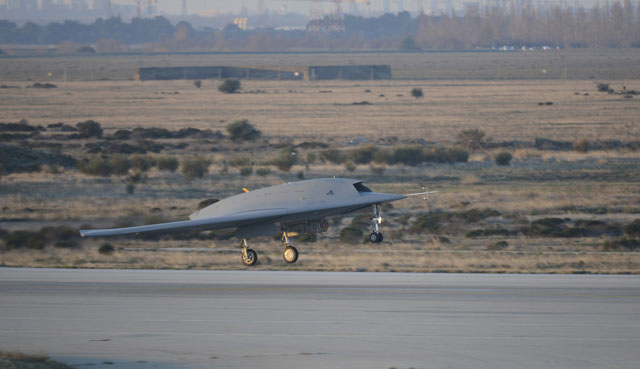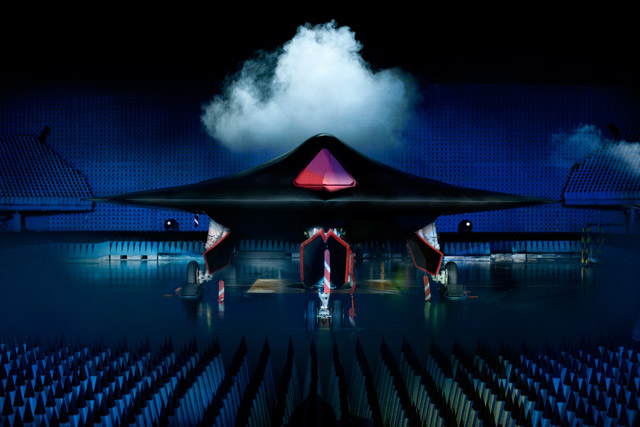"Our Istres flight test centre," boasts Charles Edelstenne, outgoing chief executive of Dassault Aviation, "has seen the first flights of more than 100 prototypes over the last 60 years. It is part of the history of French aviation."
Most recently, on 1 December 2012, Istres was the location for the maiden sortie of Dassault's most ambitious project yet, the Neuron, an unmanned combat air vehicle (UCAV).
Conceived in 2003, the Neuron is a technology demonstrator programme to inform thinking for the combat aircraft of the 2030s. It has been designed and produced by the aerospace champions of six European nations - France, Italy, Greece, Sweden, Spain and Switzerland - on a total budget of €405 million ($543 million).
 |
|---|
Dassault Dassault's Neuron UCAV made its maiden flight on 1 December 2012 from Istres in France |
Dassault has been the prime contractor for the project - "the industrial leader" - and France's defence procurement agency, the DGA, has represented its counterparts across the continent.
The UCAV features a low-observable radar signature and can fly and acquire targets autonomously. During its 25min maiden sortie, it was not remotely piloted. Instead, the details of the flight had already been uploaded to its flight computer, which analyses around 200,000 individual parameters each second, says Dassault. It represents a number of firsts, says Edelstenne, including being the first European-developed stealthy fighter.
Neuron made its second flight on 19 December in front of journalists and representatives from Europe's governments and armed forces. While not whisper-quiet, noise attenuation means that it lacks the chest-rattling punch of the manned Dassault Rafale chase aircraft that takes off shortly beforehand.
Aside from influencing future projects, the Neuron programme has allowed industry to "master the new technologies" vital for a future fighter, "whether manned or unmanned", he says. It also provides engineers with a fresh challenge beyond the current generation of European aircraft which have reached production maturity. This will ensure valuable engineering skills are not allowed to fade away.
"It's always good to be involved in projects like this," says Nikos Vassilopoulos, general manager for commercial of Greece's Hellenic Aerospace Industry. "I wouldn't say we would be left behind if we were not involved, but it's a new programme featuring state-of-the-art technology... It's important for both the company and for Greece to be part of it - we don't want to miss the opportunity."
 |
|---|
Dassault |
Other partners have slightly different motivations. Saab - which designed the Neuron's main fuselage, landing gear doors, avionics and fuel system - has a successful manned fighter programme in the Gripen, which has a backlog stretching out until at least the end of the decade. Nonetheless, the Swedish airframer recognises that this cannot last forever. "We see unmanned as the future for aviation as a whole," says Carl-Henrik Arvidsson, director and head of new business marketing and future products within Saab's aeronautics division.
Although he says some programmes, such as medium-altitude long-endurance UAVs, already appear to have momentum and there has been a willingness shown by governments to invest in them, he acknowledges that this is not the same for a UCAV: "The requirement will be driven from the government side seeing a need for a UCAV and that will be influenced by armed forces deciding what is required for the future."
For Alenia Aermacchi, Italy's representative on the programme, the rationale is simple: a fear of losing out to rivals from the USA and elsewhere. "Europe cannot keep buying off-the-shelf products from countries outside its borders. It is not only about having a European capability, but to sustain European industry," says chief executive Giuseppe Giordo. "We will need to invest in this area and to combine Europe's aerospace capability to develop programmes that can also be of interest to other markets."
Alenia's contribution to the Neuron is the design of its internal weapons bay, including an internal electro-optical/infrared sensor, the bay doors and their operating mechanisms, the electrical power and distribution system, and the air data system.
The two remaining partners are EADS' Spanish business, which produced the wings, ground station and data link integration, and Switzerland's Ruag, which has performed low-speed wind tunnel testing on the type and the interfaces between the aircraft and its weaponry.
What the multi-company effort has proved, argues Edelstenne, is that Europe's aerospace champions can work together successfully, provided they have the correct framework in place to avoid the "limitations" of existing models of collaboration. Aside from the concept of industrial and governmental leaders - the roles taken by Dassault and the DGA on the Neuron - a key stipulation of the programme was that the "contribution of the partners should be based on their existing competencies, not the ones they would like to acquire at a cost to the European taxpayer", says Edelstenne.
The Rolls-Royce Turbomeca Adour-powered Neuron will now embark on a two-year test campaign at Istres, before being transferred to the Visdel range in Sweden to undergo operational trials. It will later be moved to the Perdasdefogu range in Sardinia, Italy, for weapon-release tests. And after the test campaign... well, that's the key question. No-one is sure what will happen beyond 2014. There is no programme in place to leverage the Neuron's technology and Europe's financial crisis has ensured tight defence budgets for the foreseeable future.
Meanwhile, however, the UK's BAE Systems is continuing to develop its Taranis UCAV demonstrator, with a maiden flight pencilled in for this year. BAE and Dassault, of course, have signed a memorandum of understanding as part of the broader Franco-British Lancaster House treaty of 2010 to work together on a Future Combat Air System (FCAS) demonstrator. While Edelstenne is adamant that BAE will not be allowed to join the Neuron team, and points out that technology championed by both companies will instead "inform" the design of the FCAS.
 |
|---|
Crown Copyright Despite working together with Dassault as part of the Franco-British Lancaster House treaty of 2010 on a Future Combat Air System (FCAS) demonstrator, BAE Systems is continuing to develop its Taranis UCAV demonstrator, with a maiden flight pencilled in for this year |
"The Neuron has a certain number of partners and we have to go to the end of it. It is out of the question to bring in another partner," says Edelstenne. However, he does not rule out other parties adding their weight to the FCAS programme. Alenia boss Giordo has already indicated a willingness to participate, providing the Italian manufacturer is not handed a subordinate role by the current partners. "Clearly we will not enter with a secondary role," he says.
After the Neuron's 10min pre-programmed flight on 19 December, it landed with gentle applause from the assembled dignitaries, before being towed past hangared Mirages and Rafales to Dassault's facility on the other side of the airbase. It reappeared later as a backdrop to the press conference, looking uncannily like a museum exhibit.
Edelstenne is confident that the development process will not have been undertaken for nought. "In two years from now, the Neuron country team will have gathered a whole gamut of knowledge," he says. "It will be key for the development of the next generation of fighter aircraft, whether manned or unmanned."
And Eric Trappier, his successor as Dassault chief executive, adds: "We are convinced that future combat aircraft will be built in this way, with collaboration between European states.
"We are delighted to have been part of the adventure."
Source: Flight International
















